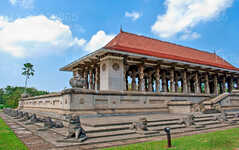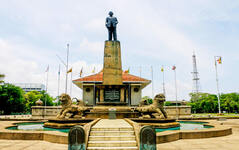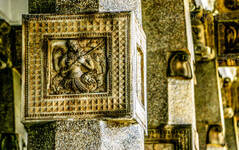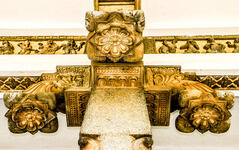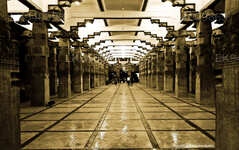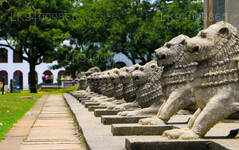
/páginas/transferências
Colombo, a capital do Sri Lanka, é uma cidade dinâmica que mistura tradição e modernidade. Ela exibe arquitetura colonial, mercados animados e templos budistas serenos. Com uma gastronomia diversificada, um horizonte crescente e belas praias, é um centro vibrante de negócios, cultura e turismo, oferecendo uma porta de entrada para explorar as maravilhas do Sri Lanka.
Independence Memorial Hall
A place to Remember
Independence Memorial Hall in Sri Lanka is mostly popular as a recreational venue for joggers, strolling couples, students from the nearby university and families looking for a refreshing reprieve from the urban environment of Colombo. Independence Memorial Hall is located in the Independence Square at Colombo 7. This place is known as Torrington Square in early days. This Hall was built for the commemoration of the independence from British in 1948. The hall was built at the location where the formal ceremony marking the start of self-rule, with the opening of the first parliament by the HRH Prince Henry, Duke of Gloucester occurring at a special podium February 4, 1948.
This Hall is based on the architecture of the Audience Hall( Magul Maduwa) located in Kandy. The column and pillers are decorated with traditional Sri Lankan designs and statues of lions are placed around the building. Most of the visitors had missed the museum located in the basement of the Independence Memorial Hall. This was recently renovated and displays many statues of the national heroes, who contributed to the fight for freedom from British government.
Independence Memorial Hall in Sri Lanka: Design
Every architectural square inch of this monument is filled with lavish symbols of the island’s rich history and political freedom. At the entrance to the building is an imposing statue of D.S. Senanayake, Sri Lanka’s first prime minister, surrounded by four menacing stone lions with protruding eyes. These feral guardians were recreated from the lion statues of the 13th century Yapahuwa kingdom. The most prominent feature of the monument, the assembly hall, was inspired by the “Magul Maduwa,” the royal court of the King of Kandy, the last kingdom on the island. Incidentally, it was at the Magul Maduwa that the Kandyan chieftains handed over the island’s sovereignty to the British throne in 1815.
The exterior of the assembly hall is decorated with “Punkalasas,” pots of plenty, which signify wealth and prosperity. The interior of the hall is supported by 60 pillars adorned with famous Embekke wood carvings from the 14th century Gampola kingdom. Made to the request of Premiere Senanayaka, who commissioned the building, it is said that he wanted a monument “worthy of this country’s long and impressive history.” Some of Sri Lanka’s most prominent architects labored over a number of sketches before the scrupulous premier granted his approval, making the Independence Memorial Hall one of the most meticulously designed buildings in the Colombo metropolis and even the whole country.
The Independence Memorial Hall is the ideal choice for those seeking a quick, relaxing getaway in the city. Much like the freedom it represents there are no entrance fees or stifling crowds; just the serenity and elegance of this historic monument and the freedom to explore and learn.
Recreational activities
Independence Square remains one of the nicest places to relax in Colombo, especially in the evenings. In addition to the memorial hall itself, there’s also the huge sprawling green lawn outside, the memorial museum and a number of cafes and shopping malls in the vicinity with easy access. It’s a favorite spot for joggers in the mornings and evenings. So much so that it’s easy to catch anybody taking a walk here at some point, from school kids to aunties to even President himself. There’s plenty of well-kept garden all around Independence Square and lovely clean paved pathways that run between. It cad definitely be said that besides Marine Drive or the beach, Independence Square is the best place in the city for some morning/evening exercise. There’s a free gym here and even a corner where you can rent a bicycle.
The Museum
On the inner end of the memorial hall that faces those square pools of water, you’ll find a brown door that leads to an eerily quiet memorial museum. It is quite hidden and your sure to miss it if you don’t play close attention. Check it out for stone busts of all those who fought for Sri Lanka’s independence, headed by leader of the Uva rebellion of 1818 himself; Monaravila Keppatipola Nilame. Independence Square is a pretty nice place, and thankfully it has been maintained well for as long as we can remember. It’s not just a historical space now but also a recreational park with an immaculate lawns, some food options and plenty of room for exercising and relaxing.
Sobre o Distrito de Colombo
Colombo é a maior cidade e capital comercial do Sri Lanka. Está localizada na costa oeste da ilha e adjacente a Sri Jayewardenepura Kotte, a capital do Sri Lanka. Colombo é uma cidade movimentada e vibrante, com uma mistura de vida moderna e edifícios e ruínas coloniais, e uma população de 647.100 habitantes. A Região Metropolitana de Colombo, definida pelos distritos de Colombo, Gampaha e Kalutara, tem uma população estimada de 5.648.000 habitantes e cobre uma área de 3.694,20 km². Colombo é uma cidade multiétnica e multicultural. É a cidade mais populosa do Sri Lanka, com 642.163 habitantes vivendo dentro dos limites da cidade. A população de Colombo é uma mistura de vários grupos étnicos, principalmente cingaleses, mouros e tâmeis. Há também pequenas comunidades de pessoas de origem chinesa, portuguesa, holandesa, malaia e indiana vivendo na cidade, bem como numerosos expatriados europeus. A grande maioria das empresas cingalesas tem sua sede em Colombo. Algumas das indústrias incluem produtos químicos, têxteis, vidro, cimento, artigos de couro, móveis e joias. No centro da cidade está localizado o segundo edifício mais alto do sul da Ásia: o World Trade Center.
Sobre o Distrito de Colombo
A Província Ocidental é a província mais densamente povoada do Sri Lanka. Abriga a capital legislativa, Sri Jayawardenepura Kotte, e Colombo, o centro administrativo e comercial do país. A Província Ocidental é dividida em três distritos principais: Colombo (642 km²), Gampaha (1.386,6 km²) e Kalutara (1.606 km²). Como centro econômico do Sri Lanka, todas as grandes corporações locais e internacionais estão presentes na cidade, assim como todos os grandes estilistas e varejistas de rua. Portanto, prepare-se para se deliciar com as compras na Província Ocidental. Com a maior população de todas as províncias, quase todas as principais instituições de ensino da ilha estão localizadas na Província Ocidental. As universidades da província incluem a Universidade de Colombo, a Universidade de Sri Jayewardenepura, a Universidade de Kelaniya, a Universidade Aberta do Sri Lanka, a Universidade Budista e Pali do Sri Lanka, a Universidade de Defesa General Sir John Kotelawala e a Universidade de Moratuwa. A província ocidental tem a maior quantidade de escolas do país, que inclui escolas nacionais, provinciais, privadas e internacionais.

